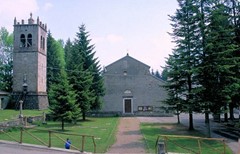Municipality of Frassinoro.
The Church of Santa Maria e San Claudio
Nestling among the rolling countryside of the Apennines near Modena, Frassinoro was to become home to a major Benedictine monastery in Matilda’s times. Sometime between the end of 1070 and the beginning of 1071 the young bride, Matilda of Canossa, gave birth to a baby girl she named Beatrice. However, it was a difficult birth and after only a few days, the little girl passed away: it was the 29th of January, 1071. On the 29th of August of the same year, Beatrice of Lorraine had the monastery of Santa Maria built, as was the custom amongst the aristocracy, so that, ‘the soul of my late granddaughter, Beatrice, might receive grace.’ In 1072, it was Beatrice who donated to the monastery the reliquaries of the martyr, Saint Claudius, from which point the church became known as “Santa Maria e San Claudio”.
The Benedictine monastery was endowed with extensive land and outstanding material wealth, while the abbey boasted an extraordinary assortment of furnishings and priceless marble sculptures, unlike the other mountain churches whose structural and decorative elements were mostly made from sandstone. Frassinoro’s fine marbles mainly came from the quarries at Carrara, however several were recycled pieces, once belonging to Roman Modena or the ancient Tuscan city of Luni. In the XV century, a landslide destroyed the abbey and the few remains were reused for the current church, in the belltower and the adjacent rectory. Incredibly ornate and imaginative sculpted columns and capitals have been inserted into the chapels, used for holy water stoups or statue bases, or superimposed as, for example, in the remarkable baptismal font inside the church. Others may be seen in the church courtyard or in the twin lancet windows of the belltower and rectory. Certain random pieces are kept in the storage museum next to the belltower.
Various fragments, two of which have been built into the wall below and next to the rectory window, display interweaving bas-reliefs with an abstract linear taste. According to some scholars, these date back to the late Middle Ages and come from an ancient chapel that sat on the spot where the abbey would later be built. Of note is one particular bas-relief from the XI century, carved into a triangular slab, which may originally have been a lunette or part of the side of a sarcophagus. In the centre is an anonymous portrait flanked by two griffons. Built into the second pillar on the left is a symbol which may represent Christ’s victory over sin, or it may be a reworking of the “Holy Face” of Lucca, as confirmation of Frassinoro’s important role in the ancient pilgrims’ ways. In fact the Via Bibulca passed here on its way to Tuscany and is still used by keen excursionists to reach San Pellegrino in Alpe. Of the abbey’s many priceless treasures, a striking Eucharistic dove may still be found at Frassinoro. This is a copper ciborium in the shape of a dove, finely chased and decorated with enamel and gemstones. In the Middle Ages, it would have been placed on a plate and hung from the altar on fine chains.
